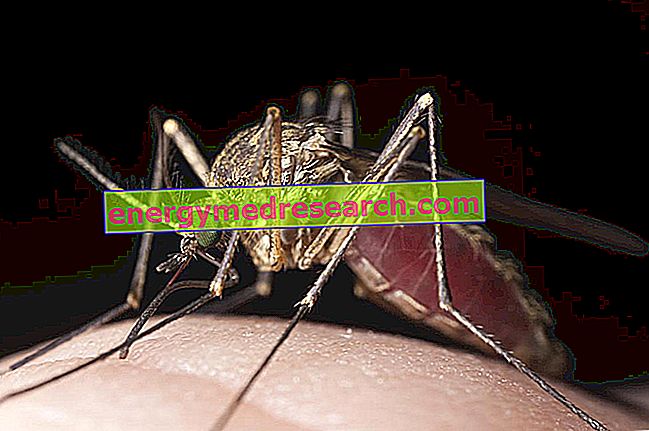Generality
The bruise is a spill of blood that collects in the layer next to the surface of the skin.

In most cases, this haematic extravasation is evident after a mild or medium trauma, which damages the small blood vessels, without causing lacerations of the skin. In the affected area, the bruise manifests itself as a relatively extensive purplish-red patch that does not disappear under pressure. However, some factors may increase the likelihood that this sign will manifest itself very easily or spontaneously, apparently without any precise cause. The bruises can be found, in fact, in the presence of pathologies and pharmacological therapies that determine:
- Excessive fragility of the vessel wall ;
- Changes in coagulation capacity ;
- Reduction in the number of platelets .
The bruise is typically associated with local pain, swelling, tingling and numbness, sometimes followed by annoying tension in the affected area. On the basis of the specific aetiology, then, other disorders can occur, such as, for example, itching and a sense of heat .
The clinical features of the bruise and its occurrence in relation to other symptoms are important aspects for the differential diagnosis. Therefore, if this sign is recurrent or persists more than it should, it is important to consult a doctor for appropriate diagnostic investigations. Normally, a bruise tends to resolve spontaneously within a few days, but some remedies can be used to speed up the healing process.
What's this
What is a bruise?
A bruise is an extravasation of blood that remains limited to the thickness of the skin . The medical significance of this red-violet color sign is variable: the contexts in which a bruise can be found range from local pathological and minor events (such as a bump or a contusion) to diseases that involve the whole organism (hematopathies, neoplasms, liver pathologies etc.), sometimes even potentially fatal. In most cases, the bruise results from a trauma that has not damaged the skin (impact, contusion, etc.).
Bruise: what difference with hematomas, ecchymoses and petechiae?
Elementary hemorrhagic lesions involving skin thickness can be subdivided - by order of size - into:
- Petechiae : they appear as very small bleeding skin blemishes;
- Ecchymosis: medical term used as a synonym for bruise; it is therefore an infiltration of blood into the thickness of the skin and into the subcutaneous tissue.
If the extravasation creates a real collection of blood associated with a visible and palpable swelling, one speaks, instead, of hematoma .
To learn more: Petecchie - Characteristics, Causes and Associated Symptoms »Causes and Risk Factors
What does the formation of a bruise depend on?
As anticipated, a bruise can be the expression of conditions of various kinds.
Most often, this sign arises when a collision or a direct injury occurs (such as, for example, a fall or a hammer) and the under-skin tissue, together with the muscle fibers, is crushed . In practice, the bruise occurs when the skin does not undergo a tear, but the capillaries located beneath the skin tissue are damaged and the blood inside them pours out, remaining trapped in the layer near the surface.
However, a bruise can also appear suddenly, seemingly without reason . In fact, blood extravasation may depend on a local problem (ie limited to certain areas of the body) or systemic diseases that make it more prone to the formation of this sign (eg liver cirrhosis, leukemia and scurvy).
Bruised by Trauma
The most common cause of the onset of a bruise is certainly a mild or moderate trauma that directly involves the area in which the reddish-purple patch forms.
In most cases, this sign occurs after accidental bumps or injuries, such as bruises, fractures and dislocations .
A bruise can also appear following:
- Bite of man or animals (dogs, cats and others);
- Domestic accidents (falls, hammering, etc.);
- Pinches, beatings, shocks and violent thrusts.

Bruised by Drugs
Some medications can cause or facilitate the formation of a bruise. These include, in particular:
- Anticoagulants (such as warfarin and heparin);
- Antiplatelet ;
- Anti-inflammatories (eg aspirin and corticosteroids).
When a bruise develops as an adverse effect on the use of a specific medicine, it is advisable to report it to your doctor and re-modulate or correct the treatment protocol.
Ease of forming a bruise: what causes?
A bruise can arise spontaneously or with great ease in the context of morbid conditions that:
- Reduce the number of platelets ( thrombocytopenia ), as in the case of:
- Hemolytic-uremic syndrome;
- Sepsis;
- HIV infections.
- Alter the coagulation capacity of the blood :
- Haemophilia;
- Leukemia;
- Systemic lupus erythematosus;
- Amyloidosis;
- Some myelodysplastic syndromes;
- Liver disease (eg liver cirrhosis);
- Disseminated intravascular coagulation;
- Vitamin K deficiency
A bruise can signal the presence of pathologies that determine an excessive fragility of the vessel wall, as happens, for example, in the presence of:
- Purple (simple or senile);
- Scurvy.
Other conditions that may predispose to bruising include:
- Acute pancreatitis;
- Aplastic anemia;
- Various infectious diseases (eg meningococcal septicemia);
- vascular;
- Connective tissue diseases, including:
- Ehlers-Danlos syndrome;
- Imperfect osteogenesis;
- Marfan syndrome;
- Inflammatory disorders of small vessels (eg phlebitis).
Predisposing and / or aggravating factors
Among the factors that can influence the greatest tendency to show a bruise are:
- Type of skin and thickness of skin tissue (a bruise is more evident on very light and thin skin);
- Aging (with age, capillaries become more fragile, therefore more prone to breakage);
- Taking certain drugs that tend to thin the blood (for example: aspirin);
- Blood pressure surges caused by excessive physical effort .
Symptoms and Complications
Livid: how do you recognize yourself?
A bruise manifests itself as an evident purplish red, relatively extensive, which does not disappear under pressure.
As the days pass, the color of the bruise changes from purplish to green or yellow, until completely resolved within 15-20 days, when the blood infiltration is reabsorbed. This chromatic variation depends on the modifications of the hemoglobin contained in the red erythrocytes, which, in the absence of pulmonary oxygenation, is transformed in succession into methaemoglobin, haematin (green-brownish), hemosiderin (greenish-yellowish) and hematoidin (yellow) .
Sometimes, the bruise may even form in an area far from the one that suffered the injury directly, as the extravasated blood can migrate. Fortunately, a bruise is not permanent and regresses spontaneously within a few days.
Bruise: what symptoms do you have?
Depending on the cause, a bruise can be associated with various other symptoms, local or systemic. The appearance of the bruise in relation to the general picture is very important for the differential diagnosis.
In addition to the evident red-purple extravasation of blood, locally, they typically occur:
- Pain, a sense of tension and local swelling ;
- Stinging and numbness in the affected area.
A bruise can involve other signs and symptoms, such as:
- Itch;
- Tingling or burning sensation;
- Hypersensitivity;
- flaking;
- Scab formation.
The systemic manifestations associated with the appearance of bruises are, however, very variable. Depending on the cause causing it, for example, general malaise, joint pain, fever, stomach ache, weight loss, weakness, palpitations and headache may occur.
When it is necessary to contact a doctor urgently

In general, the doctor should be consulted when a bruise persists and does not heal within two weeks. However, it is advisable to go immediately to the emergency room if a strong sense of pressure is perceived in the area where the impact was suffered, with an associated tingling and / or loss of sensitivity.
Furthermore, it is important to contact your doctor when you are unable to move a joint (for example, a leg or an arm) or if the bruises:
- They are formed with extreme ease (even in the absence of a precise cause, at least apparently);
- They cause severe pain or start to swell;
- The signs of an infection arise.
Diagnosis
To ascertain whether a bruise is related to particular pathological conditions that can favor its onset, it is advisable to consult, first of all, one's own doctor.
First of all, the procedure to establish the exact triggering cause involves the collection of anamnestic data and the physical examination .
Bruise: which exams are needed?
When a bruise is accompanied by other symptoms of significant importance (eg fever, dyspnea, headache, etc.) and the etiology is still uncertain, the doctor may indicate the performance of laboratory and instrumental tests.
These tests include:
- Complete blood count : identifies quantitative changes in blood cells and possible thrombocytopenia;
- Peripheral smear: examination of a microscopic blood sample to check for blood cell damage, abnormalities or immaturity;
- Prothrombin time (PT) and partial thromboplastin time (PTT), which measure the activity of coagulation factors;
- Erythrocyte sedimentation rate (ESR), PCR and other inflammation rates;
- Thyroid, hepatic and renal function tests;
- Dosage of tumor markers.
Should an anomaly emerge from one of the diagnostic investigations, further investigations are generally necessary to establish the exact causes of the bruise, confirming or excluding the various clinical suspects.
Treatment and Remedies
The treatment of a bruise varies according to the cause that is responsible for it.
In the event that this sign is caused by a trauma or a temporary disorder, in general, it is not necessary to undertake any kind of treatment, since it will gradually resolve within a few days.

Bruise: which treatment is foreseen?
To reduce the size of a bruise, as well as pain and swelling, it is useful to apply directly to the part of the cold packs, wrapping some ice cubes in a towel or cloth to protect the skin, being careful to respect the intervals of about fifteen minutes.
Even the natural active ingredients with anti-edema and anti-inflammatory action (such as arnica, bromelain, horse chestnut, pineapple and escin) can be useful in alleviating the symptoms associated with the bruise.
In the most serious cases, to mitigate the pain associated with a bruise, the doctor can indicate pharmacological treatments based on analgesic or anti-inflammatory creams. To promote and accelerate the re-absorption of extravasated blood, for example, it is possible to apply ointments, creams and gels containing heparinoids.
To avoid absolutely is instead, the emptying of the bruise (for example, trying to puncture it with a needle), since it would not accelerate the resolution of the payment.
If a bruise is caused by a specific underlying pathology, the treatment of the latter may induce the resolution of the symptomatology. Unfortunately, this does not always occur and, in some cases, this sign tends to appear even if the illness that triggered it has been adequately treated.
To counteract the predisposition to breaking the capillaries and the easy appearance of the bruises it is important to take care of the diet, limiting the salt, drinking a lot of water and consuming substances rich in flavonoids, such as wild berries and grapes.



